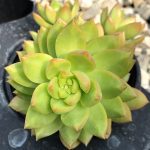Fern, Sword or Kimberly Queen; Nephrolepis obliterata
Price range: $5.99 through $12.99
Plant, Zone 9+
Discount per quantity
| Quantity | 3 - 8 | 9 - 14 | 15+ |
|---|---|---|---|
| Price | Price range: $5.81 through $12.60 | Price range: $5.63 through $12.21 | Price range: $5.39 through $11.69 |
| % Discount | 3% | 6% | 10% |
Description
Kimberly Queen Fern (Nephrolepis obliterata): A Complete Guide
The Kimberly Queen Fern, also known as the Sword Fern, is one of the most graceful and hardy ferns you can grow. With its upright fronds and deep green color, it brings a lush, tropical look to any space. This fern has earned a special place among plant lovers for being both elegant and easy to care for, indoors and outdoors.
In this guide, we’ll explore everything you need to know about the Kimberly Queen Fern, from its characteristics and care needs to practical tips for growing it successfully.
What Makes the Kimberly Queen Fern Special
The Kimberly Queen Fern is native to Australia and is part of the Nephrolepis genus. Unlike the Boston Fern, which grows with a sprawling habit, the Kimberly Queen has a more upright shape, making it a great choice for tight corners, porches, and indoor spaces. Its fronds are sword-like and finely textured, forming dense, symmetrical clumps that remain green throughout the year in mild climates.
Key Features
-
Growth Habit: Upright, clumping form with minimal shedding.
-
Fronds: Deep green, finely divided, and sword-shaped.
-
Mature Size: Typically 2 to 3 feet tall and wide when grown in ideal conditions.
-
Hardiness Zones: USDA Zones 9–11; thrives as a houseplant in cooler zones.
-
Low Mess: Unlike other ferns, it sheds fewer leaves and fronds, making it easier to maintain indoors.
Light Requirements
Kimberly Queen Ferns prefer bright, indirect light but tolerate moderate shade. Outdoors, they perform beautifully in dappled sunlight or morning sun with afternoon shade. Indoors, a spot near an east- or north-facing window works well.
-
Avoid harsh direct sunlight. Too much can scorch the fronds and cause browning.
-
Low-light tolerance. It will survive in low light but may grow slower and appear less full.
Watering and Humidity
These ferns thrive in consistently moist soil. They do not like to dry out completely, but they also don’t want soggy roots.
-
Watering frequency: Water when the top inch of soil feels dry. In warm months, this may be every few days. In cooler months, reduce watering.
-
Humidity: Kimberly Queens appreciate humidity but tolerate drier indoor air better than Boston ferns. Mist occasionally or place a tray of water and pebbles beneath the plant to boost humidity.
Soil and Fertilizer
Soil
Use a well-draining potting mix rich in organic matter. A peat-based mix combined with perlite or pine bark works well. The soil should retain moisture but not stay waterlogged.
Fertilizer
Feed during the active growing season (spring through early fall):
-
Use a balanced, water-soluble fertilizer diluted to half strength every 4–6 weeks.
-
Stop fertilizing in winter when growth naturally slows.
Temperature and Hardiness
Kimberly Queen Ferns love warm, moderate conditions:
-
Ideal range: 60–75°F (15–24°C).
-
Minimum tolerance: Around 40°F (4°C); protect from frost.
-
Outdoors, they can remain evergreen in frost-free climates and will recover from light cold snaps with minimal damage.
Pruning and Maintenance
-
Remove dead fronds: Trim any brown or damaged fronds at the base to encourage fresh growth.
-
Shape control: Cut back outer fronds if the plant becomes too wide or unruly.
-
Repotting: Every 2–3 years, repot into a slightly larger container with fresh soil to maintain vigor.
Pests and Problems
Kimberly Queen Ferns are relatively pest-free, but they can occasionally attract:
-
Scale insects or mealybugs (wipe leaves with insecticidal soap).
-
Spider mites in very dry indoor conditions (increase humidity and rinse fronds).
-
Frond browning often occurs due to low humidity, underwatering, or excessive sun exposure.
Propagation
Propagation is easiest through division:
-
Remove the fern from its pot.
-
Gently divide the root ball into sections, each with fronds and roots.
-
Replant divisions in fresh soil and keep evenly moist until established.
Best Uses
Indoors
-
Adds lush greenery to living rooms, bedrooms, or offices.
-
Perfect for bright bathrooms where humidity is naturally higher.
Outdoors
-
Great for patios, shaded porches, and entryways.
-
Excellent for mass planting in tropical or subtropical landscapes.
Why Choose the Kimberly Queen Fern
This fern stands out for its low maintenance and tidy growth habit. While other ferns drop fronds and need constant cleanup, the Kimberly Queen keeps its neat form. It’s also more sun- and drought-tolerant than most ferns, making it ideal for gardeners who want tropical style without fuss.
Tips for Thriving Plants
-
Keep soil consistently moist but never waterlogged.
-
Provide bright, filtered light for lush growth.
-
Boost humidity with misting or pebble trays, especially indoors.
-
Fertilize lightly during spring and summer for vibrant fronds.
-
Protect from frost and harsh midday sun.
Bringing Home Evergreen Elegance
The Kimberly Queen Fern is a plant that invites calm and beauty into your space. Its upright fronds stand like green sentinels, softening corners and brightening shaded spots. Easygoing yet striking, it works for both new plant parents and seasoned gardeners. Add one to your patio, entryway, or favorite indoor corner, and you’ll see how quickly it transforms the space with a quiet, natural charm.
Additional information
| Weight | N/A |
|---|---|
| Options | 2 in. (3 fl.oz.) Pot, 4 in. (16.9 fl. oz.) Pot |





